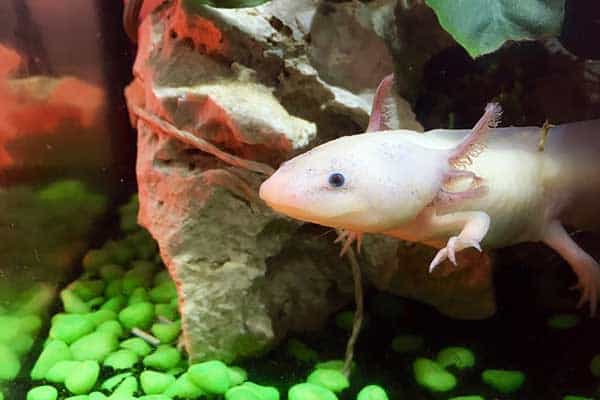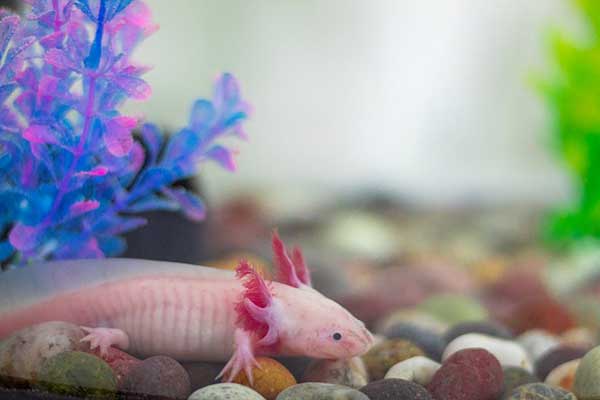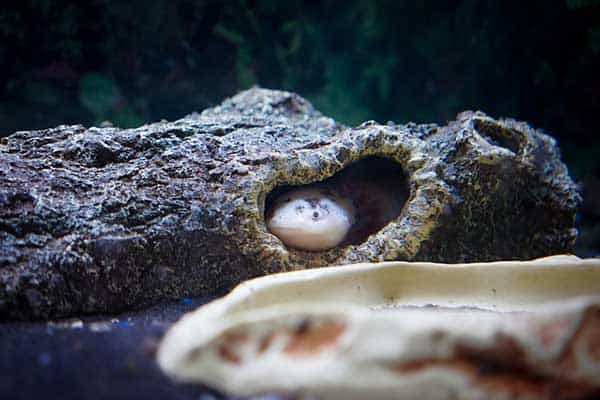Axolotls (Ambystoma mexicanum) are salamanders known for their physical appearance of looking like a “walking fish”. Found only in a small lake in Mexico City, this amphibian is believed to be the key to scientific research in the field of cancer and regeneration. In this article we’ll learn some interesting facts about axolotls as well as find out their history, their “superpowers”, and their distinct appearance.
Let’s dive in!
22 interesting facts about axolotls
Here are 22 fun facts about axolotls I dug up that I thought you might find interesting!
The axolotl is a type of salamander that seems to keep scientists on their toes in terms of learning more about them. Not only is the axolotl located only in one area of Mexico, there are actually very few of them remaining. What little is known about them is fascinating, so let’s take a look at some facts.
1. Axolotls are neotenic
The most distinguishable characteristic of the axolotl is that they are neotenic, which means they are essentially always in their juvenile stage with juvenile characteristics even though they grow into adults. As they grow into adults, they build lungs and gills. But since they retain juvenile characteristics, they also keep their external gills, body fin, and tail.
2. They can transform into full salamanders
It is rare but some species of axolotls can transform into salamanders rather than stay in their juvenile stage. Depending on the environment, an axolotl may determine it is best to be an earth-walker in which it will begin the stressful process of morphing. Though a captive axolotl can be morphed using chemicals, it is highly suggested that you not do that.
3. Axolotls have a distinct look
They look a bit like a fish, a bit like a salamander. They have what looks like 6 antennas coming out of their head, but also have feet. If that does not allow you to identify them, look for their perpetual smile always plastered on their face. It is no wonder people are so fascinated by them!
4. It’s all in the name
Axolotls are known as the “Mexican walking fish” because they actually look like walking fish. However, their name actually means “walking dog” in the Aztec language. To pronounce it, most say axe-oh-lah-tul. However, the Aztecs would have said “ash-uh-lut”.
5. They are only found in one location
You can go searching for an axolotl, but you won’t find them unless you are near the lakes and canals of Xochimilco, Mexico. In the wild, this is the only location they are found. However, they are also found in scientific laboratories around the world.
6. Good luck finding them
While they are found in the area of Xochimilco, they are still fairly difficult to find for a creature that can grow up to a foot.. Not only has their habitat dramatically declined over the last few decades, so has their population. Conservationists are working on increasing the population by creating habitats for them.
7. They have roots in mythology
The axolotl is featured in one of the myths of the Aztecs. In their mythology, Xolotl was a dog-headed dog who would turn into an axolotl to hide from the dead of the underworld. Unfortunately, the creature eventually got stuck in the waters of Xochimilco where it is unable to escape because it cannot transform and leave the water. This myth still remains popular today.

8. You can technically eat them
At one point, the native people of Xochimilco, Mexico considered the axolotl to be a special treat and were served in tamales. Known to taste like a white fish, they can now only be eaten in special restaurants in Japan where they are considered a delicacy.
9. Axolotls will bite you
Okay, so you may have to be in freshwater locations in Xochimilco, Mexico but if you are there, they can and will bite you if you get in their way. Axolotls have also been known to bite other axolotls. Most likely, they will bite their owner’s finger if they are in captivity. However, you do not have much to worry about as their bites cannot do any damage. But it might make for a cool story.
10. Even if it does take a bite, it won’t chew it
In fact, axolotls use suction rather than chewing. It will come up upon small fish, worms, and tadpoles and will suck them up like a vacuum. In fact, when the axolotls use suction while in captivity, it may suck up gravel. But do not worry, it will just help it grind the food in its stomach.
11. They are fierce predators
Do not let their smiling face fool you. They are fierce when it comes to prey. When they see their victim, they use sucking pressure from their mouth (like a really strong vacuum). The prey is unable to resist the force and is eaten by the axolotl.
12. Axolotls have a great sense of smell
Even underwater, the axolotl can smell food. They have sensory organs that not only assist them to find food but it also helps them to move around and talk to other axolotls. Since they live in extremely murky waters, this sense of smell is crucial to their survival.
13. They have a pretty distinct “headdress”
If you look at an axolotl, they have what looks like branches or antennae coming out. While it might look silly to come, they are actually extremely important: the gills. Axolotl’s have three gills on each side of their head that permit them to breathe underwater. The gills pull in water and oxygen and put it into the axolotl’s body–all while filtering carbon dioxide back into the water. Pretty impressive!

14. To find a mate, an axolotl must have moves
When a male and female start to breed, they do a dance. That starts the mating process in which they will then rub against each other while dancing. He drops his sperm (while dancing), she picks it up (while dancing), and voila!
15. There are a LOT of eggs laid
Female axolotls can lay up to 1,000 eggs at a time, though individually on plants or rocks in order to keep them safe. After about two weeks, the eggs are hatched and are immediately independent. Yes, immediately.
16. They are considered to have superpowers
Regeneration is not unheard of, but axolotls take it up a notch. They can regenerate nearly all aspects of their body. This includes their limbs, lungs, parts of their brains, skin, jaw, heart, and even their spines and lungs. Not surprisingly, scientists are very interested in not only seeing how this happens in axolotls, but also how it can happen in humans.
17. Axolotls are being studied for cancer treatments
Scientists have been studying axolotls for two reasons: the ability to regenerate and their ability to not grow malignant tumors. One scientist named Servin Zamora thinks the two are related but knows more research on the topic is needed. However, scientists are excited for the possibility of using the information they find to apply to humans fighting cancer one day.
18. They are considered healing creatures.
Axolotls have been known in Mexican cultures as healing creatures. For instance, they have been linked to being a remedy for issues related to breathing difficulties, frailty, and pregnancy. While there is no documented proof, it seems that their other amazing properties might make believers out of others!
19. It is critically endangered
We are at risk for losing axolotls forever, and quickly. While scientists and conservationists are trying hard to boost the population, habitat destruction and pollution are having devastating effects on the creature. However, with the building of new habitats, conservationists hope the number will increase to more than the approximate 1,000.
20. They do not have a lot of predators
You would think that predators have a lot to do with the low numbers, but axolotls have very few predators. While can be eaten by large birds and fish, humans remain their actual biggest predator through habitat destruction, pollution and development.
21. They were believed to have been extinct from the wild
In 2014, scientists found evidence of the axolotl being in the wild (remember we mentioned they were hard to find?). In fact, for years scientists believed axolotls were only in captivity. Scientists were thrilled at finding them because of their possible importance to the field of medicine.
22. Owning them is illegal in many states

While some people have axolotls as pets, states have begun to put in strict requirements regarding their private captivity. For instance, it is illegal to own an axolotl in New Jersey, California, Maine and Virginia. New Mexico and Hawaii require permits. However, to help build up the wild population and to avoid the risk of crossbreeding, it is suggested you do not keep one as a pet.




